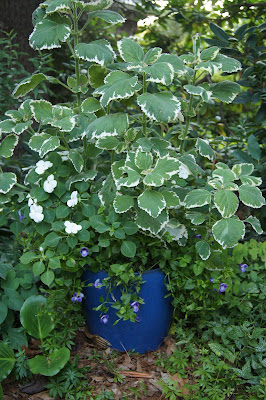 |
| Does this Asian pear have a future? |
I’ve faced this problem since I started this garden 33 years ago. Why haven’t I learned by now not to plant sun-loving plants in the shade?
Since we moved in, our backyard has been shaded by a line of Norway spruces along the southern edge of the lot. This provides useful privacy. But it also means that the garden’s southern exposure, its best chance at full sun for flowering plants, doesn’t get a full day’s sunlight.
 |
| Norway spruces block the southern exposure |
The sun has to rise beyond the level of the spruce tops, now above roof level, before direct sun hits my flower bed along the side of the garage. Right under the spruces, almost nothing will grow at all.
There’s more shade from a big oak that stands next to the back corner of the garage and a tall white pine near the spruces.
 |
| So many trees, with the oak towering over them all |
I spent several years hopefully planting classic sun perennials such as peonies, irises, and Oriental poppies. They put out floppy stems and wan, undersized leaves, reliable indicators of not enough sun. They didn’t make many flowers, and blooms that did open were small and pale.
I did finally find a place to plant those peonies in a patch of sunlight, and I enjoy seeing them bloom every spring, although they don’t make as many flowers as they would in an open area with no trees or structures nearby.
 |
| Peonies--so romantic! |
Meanwhile, as the garden expanded, I planted more trees I loved, which led over the years to more shade. There’s only so much you can do with impatiens, those stalwart shade bloomers. I have to admit that I’ve continued to push the limits, planting part-shade plants in what’s actually full shade, only to learn my lesson once again about the need for sunlight.
 | |
| For shade: impatiens, torenia, variegated foliage |
When we took down hemlocks to avoid killing native insects by spraying for hemlock woolly adelgid, I saw sunlight and quickly popped in some new shrubs and small trees. The self-pollinating Asian pear is a semi-dwarf that’s predicted to grow no bigger than 15 feet tall and 11 feet wide. Two varieties are grafted to the base, so if all goes well, we’ll have two kinds of pears, one type ripening in August and the other in September.
 |
| Picking pears in the yard would be great |
That’s a big if. Any pears that ripen in my yard are likely to be greeted enthusiastically by birds, squirrels, and raccoons.
Before that, the tree will need to get enough sunlight to be able to produce flowers—no flowers, no fruit. I’m hoping I can get by with pruning back the surrounding older, taller trees to give the Asian pear some space. That may be kind of like asking a tree to grow in an apartment building’s air shaft.

No comments:
Post a Comment